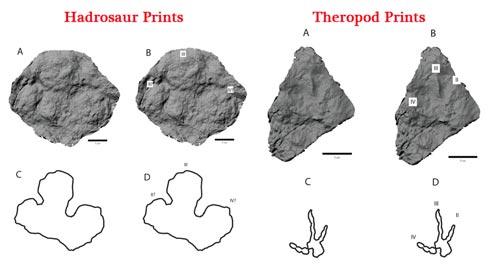Dinosaur Tracks Provide Clues to Alaska’s Rich Cretaceous Ecosystem
Trackways Provide Palaeontologists with an Insight into Alaskan Dinosaurs
The remote Wrangell mountain range of eastern Alaska is proving to be a happy hunting ground for palaeontologists as they strive to find out about the dinosaurs that once roamed these high latitudes. During the Late Cretaceous, this part of Alaska, which is now an area of rugged mountains built up as a result of extensive vulcanism, was much warmer than it is today, although it was much nearer to the North Pole. The habitat consisted of dense conifer forests with an understorey of hardy flowering plants and ferns. These forests were home to a number of dinosaur species as well as many seasonal migrants that came north to graze on the vegetation during the long summer days. With nearly four months of near total darkness and temperatures dropping to well below zero degrees Celsius, scientists had thought that the onset of winter would have led to conditions that the dinosaurs, as reptiles, could not tolerate. However, thanks to the discovery of extensive dinosaur tracks, palaeontologists are beginning to build up a picture of a vibrant ecosystem which featured both indigenous and dinosaur seasonal migrants.
Dinosaur Tracks
Tony Fiorillo, a dinosaur expert with the Museum of Nature and Science (Dallas, Texas), has visited these mountains on numerous occasions and during these field trips he has been able to find a number of exciting vertebrate fossil specimens. His latest catalogued discoveries include fossilised footprints of two different types of dinosaur, the fossils being discovered near the small town of Chisana in the Wrangell mountain range.
Whilst exploring a fossiliferous stream bed in the St. Elias National Park, with Thomas Adams of San Antonio College, Yoshitsugu Kobayashi of Hokkaido University and Linda Stromquist of the National Park Service back in 2008, Mr Fiorillo found a plate-sized rock that contained the clearly visible imprint of the middle toe of a large three-toed dinosaur. By squinting at the rock and holding it at different angles, he was able to make out the rest of the footprint. Nearby he found a second dinosaur track, this time the footprint of a much smaller, lighter animal. The tracks have been identified as belonging to a duck-billed dinosaur, otherwise known as a hadrosaur. The smaller track would have have been made by a theropod (likely to be meat-eating dinosaur or possibly an ornithomimid).
These prints are the first evidence of dinosaur tracks to have been found in this part of the Wrangell Mountains.
Pictures and Line Drawings of the Dinosaur Prints
Picture credit: Tony Fiorillo
Hadrosaur Tracks
The hadrosaur tracks are similar to those discovered in other parts of Alaska. Palaeontologists have postulated that large herds of these plant-eating dinosaurs migrated northwards each year to take advantage of the lush vegetation and the almost 24-hours of daylight in the summer months, permitting rapid plant growth.
Following the herds would have been predatory dinosaurs, such as tyrannosaurs. The smaller track-way may represent that of an indigenous carnivore, an animal that lived in the Alaskan region all year round but relied on the bounty of scavenging the kills of bigger dinosaurs to see it through the harder winter months.
Mr Fiorillo, described the smaller dinosaur:
“This little guy ran around on two legs, might have been six feet from snout to tail and had a bunch of little pointy teeth and sharp claws. He was eating meat, but there was a lot of this ecosystem we didn’t pick up (fossils that would indicate what the dinosaur as tall as a small child was eating).”
Palaeontologists know that troodontids lived in this part of the world during the Late Cretaceous, these small, light predators grew to lengths in excess of four metres and weighed perhaps as much as 100 kilogrammes, but the tracks are not representative of a troodontid. Troodontids run on only two toes and these prints definitely show a three-toed animal walking on all of its toes.
Mr. Fiorillo and his co-dinosaur hunters are looking forward to returning to the location in future, so they can find more evidence of the region’s Late Cretaceous inhabitants.
For models and scale replicas of theropod dinosaurs and hadrosaurs: Theropod and Hadrosaur Models (CollectA Deluxe Figures).


